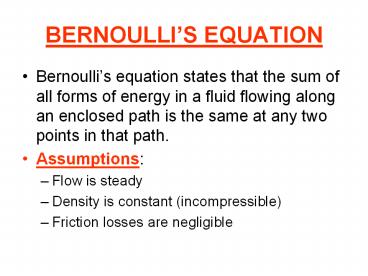BERNOULLI - PowerPoint PPT Presentation
1 / 26
Title:
BERNOULLI
Description:
BERNOULLI S EQUATION Bernoulli s equation states that the sum of all forms of energy in a fluid flowing along an enclosed path is the same at any two points in ... – PowerPoint PPT presentation
Number of Views:429
Avg rating:3.0/5.0
Title: BERNOULLI
1
BERNOULLIS EQUATION
- Bernoullis equation states that the sum of all
forms of energy in a fluid flowing along an
enclosed path is the same at any two points in
that path. - Assumptions
- Flow is steady
- Density is constant (incompressible)
- Friction losses are negligible
2
BERNOULLIS EQUATION
3
- By conservation of energy,
- (Energy)1 (Energy)2
- S(Energy) 0
- D (Press. forces) D (Kinetic Energy)
- D (Potential Energy) 0
4
- Pressure forces F S
- Kinetic Energy ½ m v2
- Potential energy m g h
- Pressure forces _at_ 1 are given by,
5
- Sub. all the values in the energy balance
equation
All are having an units of J/kg
Bernoullis eqn
6
Applications of B.Eqn
- B.E often combined with continuity equation to
find velocities pressures in the flow connected
by a streamline - Orifice meter venturi meter
- Flow in pumps etc.,
7
Fluid friction
- Fluid friction is defined as any conversion of
mechanical energy into heat in a flowing stream - Denoted by the letter hf (J/kg)
- hf represents all the friction generated per unit
mass of fluid bet (1) (2) - B.E becomes..
8
Pump work.
- If a pump is used during flow, then the term
work done by the pump should be added to B.E
9
Prob 1
- A fluid of density 960 kg/m3 is flowing steadily
thro a tube as shown in the fig The sections
diameters are d1100mm d280mm. The press p1
200kN/m2 u15m/s. The tube is horizontal. What
is the pressure at section(2)?
10
- By continuity equation
- v2 7.8125 m/s
- From B.E.
- p2 182.703 x 103 N/m2
11
Prob 2
- Gasoline(680 kg/m3) flows from a 0.3m dia pipe in
which the pressure is 300kPa into a 0.15m dia
pipe in which the press is 120kPa. If the pipes
are horizontal viscous effects are negligible,
determine the flow rate
12
- By continuity equation
- v2 4 v1
- From B.E.
- v1 5.94 m/s
- Flow rate, Q A1v1 0.4199 m3/s
13
Prob 3
- Water flows steadily thro the pipe shown in fig.
such that the press _at_ sections 1 2 are 300kPa
100kPa respectively. Determine the dia of pipe _at_
section 2, if the velocity at section 1 is 20m/s
and viscous effects are negligible
14
- From B.E.
- v2 42.2 m / s
- By continuity equation
- D2 0.0688m
15
Prob 4
- Water with a density of 998 kg/m3 is flowing at a
steady mass flow rate through a uniform-diameter
pipe. The entrance pressure of the fluid is 68.9
kN/m2 in the pipe, which connects to a pump which
actually supplies 155.4 J/kg of fluid flowing in
the pipe. The exit pipe from the pump is the same
diameter as the inlet pipe. The exit section of
the pipe is 3.05 m higher than the entrance, and
the exit pressure is 137.8 kN/m2. The Reynolds
number in the pipe is above 4000 in the system.
Calculate the frictional loss hf in the pipe
system.
16
- From B.Eqn
- Since dia of pipe is same.v1 v2
- hf 56.44 J/kg
17
Prob 5
- A pump draws 69.1 gal/mm of a liquid solution
having a density of 114.8 lbm/ft3 from an open
storage feed tank of large cross-sectional area
through a 3.068ID suction line. The pump
discharges its flow through a 2.067ID line to an
open overhead tank. The end of the discharge line
is 50 ft above the level of the liquid in the
feed tank. The friction losses in the piping
system are 10.0 ft-lbf /lbm. What is the
horsepower of the pump if its efficiency is 65?
What pressure must the pump develop?
18
(No Transcript)
19
- r 114.8 lbm/ft3
- ?114.8 (0.454) / (0.3048)3
- Therefore, r 1840.6 kg/m3
- hf 10 ft-lbf / lbm
- ?10(0.3048m)(4.4482N) / (0.454)
- Therefore, hf 29.864 J/kg
20
- Apply B.Eqn bet (1) (2)
- Since p1 p2 (open to atmosphere)
- h1 h2 50 15.24m
- v2 2.0315 m/s (for 2.067)
- Since tank dia is very high..v1ltltv2 v1/v2
A1/A2 - v1 0
- Sub all values in B.Eqn.Wp 2239.057 J/s
- Or Wp 3.005 HP 1HP 745 W
21
- The press. developed in the pump (ie bet 3 4)
- Since hf is only for piping system..here for
pump..hf 0 - h3 h4 and v4 v2 2.035 m/s
- v3 0.91395 m/s (for 3.068)
- Sub all the values in the B.Eqn.
- (p3 p4) 330.833 kPa..pressure developed by
the pump
22
Time for emptying a tank
- Consider a steady flow of water from a tank of
height H - Hi and Hf are initial final height of water in
the tank
23
- Applying B.Eqn.
24
- We know, Q1 Q2
25
Prob 6
- Draining Cotton Seed Oil from a Tank
- A cylindrical tank 1.52 m in dia and 7.62 m high
contains cotton seed oil having a density of 917
kg/m3. The tank is open to the atmosphere. A
discharge nozzle of inside diameter 15.8mm and
cross-sectional area A2 is located near the
bottom of the tank. The surface of the liquid is
located at - H 6.1 m above the center line of the nozzle.
The discharge nozzle is opened, draining the
liquid level from H6.1 m to H4.57 m. Calculate
the time in seconds to do this.
26
- We know,
- At CSA of tank (p/4)D2
- Therefore, t 1387 sec































